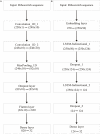Riboflow: Using Deep Learning to Classify Riboswitches With ∼99% Accuracy
- PMID: 32760712
- PMCID: PMC7371854
- DOI: 10.3389/fbioe.2020.00808
Riboflow: Using Deep Learning to Classify Riboswitches With ∼99% Accuracy
Abstract
Riboswitches are cis-regulatory genetic elements that use an aptamer to control gene expression. Specificity to cognate ligand and diversity of such ligands have expanded the functional repertoire of riboswitches to mediate mounting apt responses to sudden metabolic demands and signal changes in environmental conditions. Given their critical role in microbial life, riboswitch characterisation remains a challenging computational problem. Here we have addressed the issue with advanced deep learning frameworks, namely convolutional neural networks (CNN), and bidirectional recurrent neural networks (RNN) with Long Short-Term Memory (LSTM). Using a comprehensive dataset of 32 ligand classes and a stratified train-validate-test approach, we demonstrated the accurate performance of both the deep learning models (CNN and RNN) relative to conventional hyperparameter-optimized machine learning classifiers on all key performance metrics, including the ROC curve analysis. In particular, the bidirectional LSTM RNN emerged as the best-performing learning method for identifying the ligand-specificity of riboswitches with an accuracy >0.99 and macro-averaged F-score of 0.96. An additional attraction is that the deep learning models do not require prior feature engineering. A dynamic update functionality is built into the models to factor for the constant discovery of new riboswitches, and extend the predictive modeling to new classes. Our work would enable the design of genetic circuits with custom-tuned riboswitch aptamers that would effect precise translational control in synthetic biology. The associated software is available as an open-source Python package and standalone resource for use in genome annotation, synthetic biology, and biotechnology workflows.
Keywords: clustering; convolutional neural network; hyperparameter optimization; machine learning; multiclass ROC; recurrent neural network; riboswitch family; synthetic biology.
Copyright © 2020 Premkumar, Bharanikumar and Palaniappan.
Figures





Similar articles
-
Design of ear-contactless stethoscope and improvement in the performance of deep learning based on CNN to classify the heart sound.Med Biol Eng Comput. 2023 Sep;61(9):2417-2439. doi: 10.1007/s11517-023-02827-w. Epub 2023 Apr 27. Med Biol Eng Comput. 2023. PMID: 37103637 Free PMC article.
-
Tuning the Performance of Synthetic Riboswitches using Machine Learning.ACS Synth Biol. 2019 Jan 18;8(1):34-44. doi: 10.1021/acssynbio.8b00207. Epub 2019 Jan 8. ACS Synth Biol. 2019. PMID: 30513199
-
A comparative study on deep learning models for text classification of unstructured medical notes with various levels of class imbalance.BMC Med Res Methodol. 2022 Jul 2;22(1):181. doi: 10.1186/s12874-022-01665-y. BMC Med Res Methodol. 2022. PMID: 35780100 Free PMC article.
-
Tapping the potential of synthetic riboswitches: reviewing the versatility of the tetracycline aptamer.RNA Biol. 2023 Jan;20(1):457-468. doi: 10.1080/15476286.2023.2234732. RNA Biol. 2023. PMID: 37459466 Free PMC article. Review.
-
RNA aptamers as genetic control devices: the potential of riboswitches as synthetic elements for regulating gene expression.Biotechnol J. 2015 Feb;10(2):246-57. doi: 10.1002/biot.201300498. Biotechnol J. 2015. PMID: 25676052 Review.
Cited by
-
Linker-Mediated Inactivation of the SAM-II Domain in the Tandem SAM-II/SAM-V Riboswitch.Int J Mol Sci. 2024 Oct 20;25(20):11288. doi: 10.3390/ijms252011288. Int J Mol Sci. 2024. PMID: 39457069 Free PMC article.
-
Identification of potential riboswitch elements inHomo SapiensmRNA 5'UTR sequences using Positive-Unlabeled machine learning.bioRxiv [Preprint]. 2024 Dec 6:2023.11.23.568398. doi: 10.1101/2023.11.23.568398. bioRxiv. 2024. Update in: PLoS One. 2025 Apr 24;20(4):e0320282. doi: 10.1371/journal.pone.0320282. PMID: 39677788 Free PMC article. Updated. Preprint.
-
A Dense RNN for Sequential Four-Chamber View Left Ventricle Wall Segmentation and Cardiac State Estimation.Front Bioeng Biotechnol. 2021 Aug 6;9:696227. doi: 10.3389/fbioe.2021.696227. eCollection 2021. Front Bioeng Biotechnol. 2021. PMID: 34422778 Free PMC article.
-
Identification of potential riboswitch elements in Homo sapiens mRNA 5'UTR sequences using positive-unlabeled machine learning.PLoS One. 2025 Apr 24;20(4):e0320282. doi: 10.1371/journal.pone.0320282. eCollection 2025. PLoS One. 2025. PMID: 40273288 Free PMC article.
-
End-to-end computational approach to the design of RNA biosensors for detecting miRNA biomarkers of cervical cancer.Synth Syst Biotechnol. 2022 Apr 4;7(2):802-814. doi: 10.1016/j.synbio.2022.03.008. eCollection 2022 Jun. Synth Syst Biotechnol. 2022. PMID: 35475253 Free PMC article.
References
-
- Abadi M., Agarwal A., Barham P., Brevdo E., Chen Z., Citro C., et al. (2015). TensorFlow: Large-Scale Machine Learning on Heterogeneous Systems. Available online at: www.tensorflow.org (accessed May 10, 2018).
LinkOut - more resources
Full Text Sources

